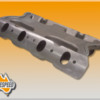quote:
Originally posted by Tom@Seal Beach:
Doug said "The IDA transition "issue" can be minimized by adding a third transition hole in the carb."
__________________________________________
Doug please explain, I've never heard of that.
Also can anyone give their personal experiences on the IDF's on a Cleveland?
Is the Cain manifold a magnesium or aluminum? Looks like pickled mag...sort of like the McKay magnesium manifold I ran on the SBC. I personally wouldn't want a magnesium manifold on a street driven car. I had to drain the cooling system every time the car sat for more than a day because the magnesium corroded so quickly. A deal killer for a street car driven on a regular basis.
Also, will the IDF's WITH an air cleaner fit under the deck lid?
The IDF is being touted as a street carb vs the IDA, a racing carb.
If you catch the comments about the IDF, "it has a mid-range circuit".
One of the idiosyncrasies of the IDA is that on an IR manifold on a V8, there is an rpm range, observed on most cars to be about a 400rpm spot, between 2,500 rpms and 3,200 rpms where the engine becomes unresponsive to throttle input, i.e., a flat spot.
I do not know if the transition flat spot exists if the carb is used on a common plenum manifold. It may be a IR manifold issue. Don't know.
This is caused by the design of the carb itself.
It has a hole in the throttle bore, below the throttle butterfly through which the idle adjustment screw projects. It has another just above the throttle plate at idle position.
This is usually called the idle transfer slot in other carbs like the Holley. On the IDA, it isn't a slot, it's these two holes.
Now, cut me some slack on this because I am doing this from memory, ok?
I believe there are two holes in there. The access to them is through the slotted brass screw under the idle adjustment screw.
I believe there are two holes, one like I said for the idle screw needle, another above it maybe at 3/16" higher, above the throttle plate and at the notch in the plate.
That distance between the two is the significant part to this transition between idle/part throttle and main fuel system.
That distance also coincides with the "transition flat spot" of the mentioned rpm spread above.
In attempting to eliminate or reduce the flat spot, some "tuners" have added a third hole, in between those two existing.
This lets the idle circuit continue to a higher rpm range overlapping the main circuit kick in.
Now I personally think that because these are hole and not slots (like in a Holley) you can not entirely eliminate the flat spot with it, but you certainly can reduce it.
I do not have this modification on my carbs. Some days my flat spot is there, some days it isn't. That does have to do with a lot of things including the size of the chokes, and most importantly, the WEATHER. Clean, dry low humidity air accentuates the flat spot. More humidity tranquilizes it some.
IDA's change with the weather, like it or not.
The bigger the chokes, the more consistent the flat spot seems to be there...seemingly.
This is probably one of the modifications Inglese will do on a carb that he knows will be used on the street. An IDA that is. The IDF doesn't need it.
As far as the IDF's being shorter, along with the manifold, I will say this, the IR systems are sensitive to ram tuning length. The longer the better.
Have you ever seen the long ram tubes on the IDA's? What do you think they are there for?
The longer they are, the more torque they add, and it is noticeable.
Like I said, I haven't worked with the IDF's, but the entire ram length to the valve is noticeably shorter then the IDA.
I'd bet you a nickle that adds to loss of drive ability of the IDF's? Again, IR carb systems are VERY, VERY SENSITIVE to induction length.
You may be attempting to reinvent the wheel with the IDF's?
Nothing naturally aspirated (carbs)seem to run with IDA's flat out. Maybe the IDF's come close, I don't know?
That's my explanation Tom. Best I can do. Hope it makes sense to you and helps?












